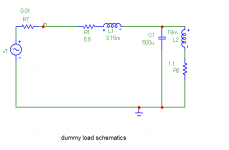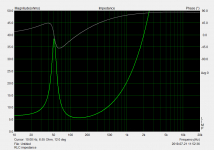Yes I agree with what your saying, it still doesn’t explain the differences heard that are explained as bias, fud, trolling, etc.....
I don’t want to become labeled a troll so I’m not going argue the minutia involved but apparently I’m one of these 5% and find what differences I hear dismissed as if they don’t exist?
I don’t want to become labeled a troll so I’m not going argue the minutia involved but apparently I’m one of these 5% and find what differences I hear dismissed as if they don’t exist?
The distortion issue on reeds would never have been noticed, even Ed can't measure the third harmonic of 20fA. 🙂 We needed the off resistance of >10**15 Ohms.
I thought so as you mentioned the "measuring of very small currents case". 🙂
But the "magnetic issues" of relais illustrates why the (plausible looking) conclusion from one case to another can be quite misleading.
I ran into such a problem quite a long time ago; the everlasting game of expansion and (later) concentration of business lines led to selling of the relais (and other passive part manufacturing) sector to a competitor. The new owners continued to produce a specific relais type (same package, same footprint, same specifications - even copied the old ones - , of course changed the package marking).
After some time I used the new relais for the same amplifier model as the original ones before, but the THD+N number measured went up from the former ~0.001% to ~0.0035% (8Ohms, 1 kHz, 23W, BW 80 KHz).
Checking a lot of things showed that everything was working as intended, but at the end I found out that the new relais was changed in an internal detail, a short piece of wire inside wasn't made from a diamagnetic material anymore but was ferromagnetic one instead.
Isn't Pavel showing the current distortion caused by the varying load impedance? I'm confused by Richard's comments, is that the point?
Yes, it is the distortion caused by frequency dependent non-linear impedance. Non-linear is the key word here and it is the non-linearity of the inductance of the coil L2 with ferrite core that starts to saturate.
Attachments
Jakob, you asked me why I think there are errors in the article: Loudspeakers: Effects of amplifiers and cables - Part 5 | EE Times, by By Philip Newell and Keith Holland, published in EE times.
As you did not say "I think there could be...." but instead asserted that there were "measurement and experimental errors", I was surprised and interested in the evidence.
First set of measurements, shown as Figure 6.10 (a-f), shows “Effects of cable on 1.6 kHz square wave. All upper traces are from the amplifier output terminals; all lower traces are from the loudspeaker input terminals”.
I mentioned the article after you've showed your multitone measurements and pointed to the multitone measurements done by Voishvillo, Terekhov and Czerwinski, i.e. fig.6.7 - 6.9, which were the first set of measurements shown.
So, basically your critic is not related to these measurements done by Voishvillo et al., is it?
but the THD+N number measured went up from the former ~0.001% to ~0.0035% (8Ohms, 1 kHz, 23W, BW 80 KHz).
-90dB or so would be a stretch from Bruno's measurements unless one was routing the output current through one. For some applications only the break action has interest (charged line pulse generators) because it is bounce free. When open there is no current so no distortion.
'Not invented here' and so it goes, if it does not fit theoretical models/belief systems then it can't exist and then rude and derisory responses are the norm. Bob, too bad you don't live around the corner, if you did I would invite you to hear Goop treated audio and try some Goop treated wine......that offer also stands for anybody passing through or living in Perth, WA, drop me a PM. Good on you for experimenting and making observations, that's what Diy is all about.I would like to know why I (and others) can hear things we’re not supposed to? And it’s not because someone planted the seed.....it’s because I heard a difference and dug until I found an explanation. Explanations that are then relegated to the ‘fud’ bin.
Dan.
Re Fig.6.7 - 6.9 I cannot see enough information in the EE article (Newell ...) to see experiment description and what they were actually measuring. So, no comments.I mentioned the article after you've showed your multitone measurements and pointed to the multitone measurements done by Voishvillo, Terekhov and Czerwinski, i.e. fig.6.7 - 6.9, which were the first set of measurements shown.
So, basically your critic is not related to these measurements done by Voishvillo et al., is it?
Any proof about this ability to "hear" differencies, supported by controled blind test?? 🙄I would like to know why I (and others) can hear things we’re not supposed to?
^ According to Mark, the cost of providing any evidence of hearing ability of the so called 5%ers would be prohibitive 😎 By evidence, I mean real evidence of course, just in case he wants to tell me hearsay counts.
Last edited:
Yes, it is the distortion caused by frequency dependent non-linear impedance. Non-linear is the key word here and it is the non-linearity of the inductance of the coil L2 with ferrite core that starts to saturate.
I think distortion - in many amplifiers- also varies considerably over speaker impedance because of the current drive requirements. At or near resonance, little current is drawn from the amp output, but at the low Z point(s) at typically a few hundred Hz, some speakers will drop to 3 Ohms and demand much more current from the amp.
Good amplifiers will show little difference in distortion over wide speaker loads (3 Ohms and up).
I would expect cross overs to use air cores - no saturation. Or are you referring to the speaker coil itself? But if it’s going heavily non- linear, surely that’s an ‘overdrive’ issue rather than an amp issue?
Another form of proof is when many people describe hearing a difference in exactly the same manner. I love using medical as an example because it uses people feedback for accuracy.
If most people say this white powder called aspirin makes their headache go away, it is true then. No other "tests" need to be done to know if it makes headaches go away. Does not matter if you know why it does so or not. Does not matter that you cant show a test measurement data to "prove" it does what people describe. Nor matter if you have a test which shows no change occurred in the person. The people's experience and perception of the aspirin effect is true and real.
THx-RNMarsh
If most people say this white powder called aspirin makes their headache go away, it is true then. No other "tests" need to be done to know if it makes headaches go away. Does not matter if you know why it does so or not. Does not matter that you cant show a test measurement data to "prove" it does what people describe. Nor matter if you have a test which shows no change occurred in the person. The people's experience and perception of the aspirin effect is true and real.
THx-RNMarsh
Last edited:
Pavel said : "The amps were loaded with a RLC dummy load that simulates a free-standing woofer quite well. The big inductance is a ferrite core coil, which is pretty non-linear and in this regard it simulates speaker non-linearity quite well."
That would be synonymous with a night and day difference I would think, don't need many people for that 😉Another form of proof is when many people describe hearing a difference in exactly thee same manner. I love using medical as an example because it uses people feedback for accuracy.
If most people say this white powder called aspirin makes their headache go away, it is true then. Does not matter if you know why it does so or not. Does not matter that you cant show a test measurement data to "prove" it does what people describe.
Any proof about this ability to "hear" differencies, supported by controled blind test?? 🙄
If I’m being critical I usually listen with my eyes shut or in the dark 😉
I’ve got no incentive to fool myself.....it is what it is.
^ According to Mark, the cost of providing any evidence of hearing ability of the so called 5%ers would be prohibitive 😎
I don’t find the need to prove anything to give (or take) a subjective opinion.
So we can ignore what you say when you refer to yourself as one of the 5%er's, thanks for clearing that up. 🙂I don’t find the need to prove anything to give (or take) a subjective opinion.
Pavel said : "The amps were loaded with a RLC dummy load that simulates a free-standing woofer quite well. The big inductance is a ferrite core coil, which is pretty non-linear and in this regard it simulates speaker non-linearity quite well."
That would be synonymous with a night and day difference I would think, don't need many people for that 😉
it applies even when not night and day if enough people say they have heard same described results. What is enough people? Heyser thought it is 2 or more.
So, when Mark and I heard the mod and unmod BenchMark DAC3 exactly the same as we both described it --- it is true. We dont have to know why or how or do some defining test before and after. Or when thousands of people say they detect differences with capacitor dielectrics then it is true. No need to know why, but if it can be correlated to a test, so much the better.
THx-RNMarsh
Last edited:
Medical experiments often use also placebo to verify real results. .And many peoples reported same results with placebo. Simply because they believe ( expect) in change...😉Another form of proof is when many people describe hearing a difference in exactly thee same manner.
I love using medical as an example because it uses people feedback for accuracy.
If most people say this white powder called aspirin makes their headache go away, it is true then. No other "tests" need to be done to know if it makes headaches go away. Does not matter if you know why it does so or not. Does not matter that you cant show a test measurement data to "prove" it does what people describe. Nor matter if you have a test which shows no change occurred in the person. The people's experience and perception of the aspirin effect is true and real.
THx-RNMarsh
So we can ignore what you say when you refer to yourself as one of the 5%er's, thanks for clearing that up. 🙂
Hey it’s you fellers that labeled it.....no idea I was one before coming on here, I just thought I had a ‘good ear’ turns out 95% of the population is disabled!😀
You still might not be, thought of that? 😉
BTW, the above is a good example of FUD
BTW, the above is a good example of FUD
Last edited:
- Status
- Not open for further replies.
- Home
- Member Areas
- The Lounge
- John Curl's Blowtorch preamplifier part III

